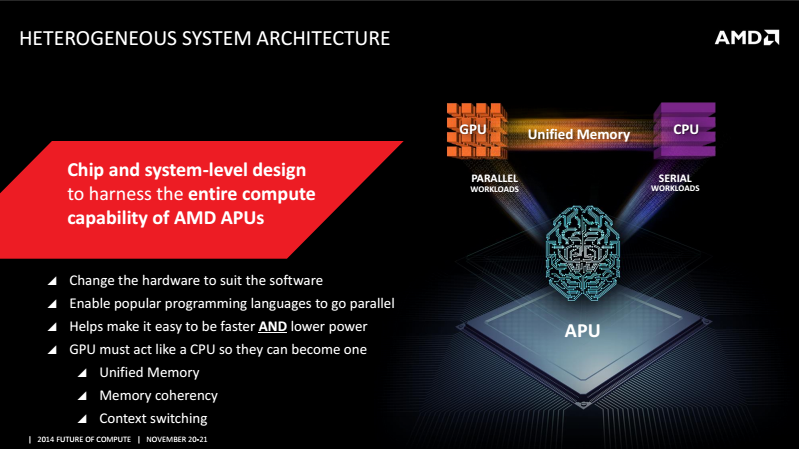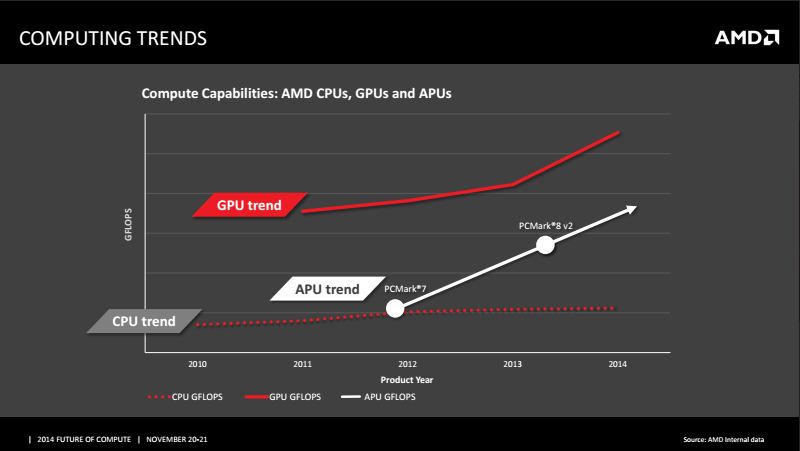AMD Debuts Its First HSA-Compliant Chips With Carrizo And Carizzo-L
Today, at its "Future of Compute" event, AMD announced its first high-performance SoC, called Carizzo, which is based on the new Excavator CPU micro-architecture and a next-generation Radeon GPU architecture. (AMD isn't revealing too much right now about the next-gen Radeon bit.)
The SoC was designed to use the Heterogenous Systems Architecture (HSA) to take full advantage of GPU compute, increase performance and energy efficiency. Carizzo is the first HSA 1.0-compliant SoC to come to market. Other HSA-compliant SoCs are expected to arrive from HSA Foundation partners such as ARM, Qualcomm and Marvell, but they haven't announced any official HSA chips so far.
AMD also announced the "Carrizo-L," a lower-end SoC that comes with AMD's "Puma+" CPU and its old GCN GPU architecture, which should go into tablets, low-end Windows notebooks, and possibly some Chromebooks, as well. The two chips will support Windows 10, DirectX12, OpenCL 2.0, AMD Mantle API, and AMD's FreeSync technology.
Both chips will also come with "AMD Secure Processor," which is actually based on an ARM processor (Cortex A5 in the past, but could be Cortex A7 or even Cortex A53 this time) and ARM's TrustZone technology, which can keep sensitive data separated from the main OS or apps that aren't supposed to access that data.
"We continue to innovate and build upon our existing IP to deliver great products for our customers," said John Byrne, senior vice president and general manager, Computing and Graphics business group, AMD. "AMD's commitment to graphics and compute performance, as expressed by our goal to improve APU energy efficiency 25x by 2020, combines with the latest industry standards and fresh innovation to drive the design of the 2015 AMD Mobile APU family. We are excited about the experiences these new APUs will bring and look forward to sharing more details in the first half of next year."
HSA -- or the unification of the CPU, GPU, and other co-processors and accelerators -- has been in the works for more than two years, but in a way it's an evolution of AMD's "APU" strategy, which aimed to keep the CPU and GPU as close together as possible.
AMD is in a unique position to do this in the PC market, because it can make both the CPU and GPU. Nvidia, for example, cannot. Nvidia's Maxwell GPU architecture will also support many of the same features that are needed for heterogeneous computing, but because the company doesn't have its own x86 CPU, its chips can't benefit from the same kind of integration. Nvidia can only do it in the mobile market with Tegra K1's successor, just like Qualcomm or Imagination (with its MIPS CPUs and PowerVR GPUs).
Get Tom's Hardware's best news and in-depth reviews, straight to your inbox.
Intel could follow a similar path as AMD, but in terms of tight integration between the CPU and GPU, Intel is a few years behind. While AMD was working on APUs, and on making GPUs act as CPUs, Intel was doing the opposite -- researching whether it can make many low-end CPUs act like a GPU. The Intel Xeon Phi, which is already on the market, works in this way, but it's only available for servers or supercomputers.
Intel may eventually try to push the "Phi" design to PCs and mobile as well, but the attempt could have a high risk of failure if it radically changes the way games are made without giving game developers a significant advantage over building their games for GPUs.
Even so, such integration on Intel's part is still a few years away. In the meantime, AMD's Carizzo and Carizzo-L HSA chips will launch next year, and other HSA chips from its ARM partners are likely to follow soon after. This will entrench the HSA model in the market and give developers a chance to become comfortable with it.
Follow us @tomshardware, on Facebook and on Google+.
Lucian Armasu is a Contributing Writer for Tom's Hardware US. He covers software news and the issues surrounding privacy and security.
-
dovah-chan I can't wait to start learning how to code for HSA. Hopefully this is where the market is going to lean towards. I think it's a great concept.Reply -
TechyInAZ This will be awesome when it comes out, finally APUs will be able to beat i5s and i7s when doing heavy computing.Reply -
IInuyasha74 I'm hoping this really plays out well for AMD so they can have a strong market share again and make it into mobile areas. Really hoping that Imagination picks up on it too so that they can start getting market share in the mobile and laptop world. I don't think ARM will be so fast to pick up on it, since they could only guarantee its full functioning when their Mali GPU tech is used and that just isn't always done.Reply -
photonboy I think Unreal 4 engine will end up with highly optimized code which can automatically choose to use the best method based on the hardware.Reply
Let the Unreal geeks do the heavy lifting. -
rokit While its nice as the beginning. The problem with this is software that won't have support for it outside of your own ofcourse. It will take along time unless AMD will start cooperating heavily with software companies and start with something big like 3D creating software, encoding, data bases.Reply -
loosescrews Intel already tried to make a consumer x86 GPU, but they cancled it pretty far along in devolopement after it became clear that it wouldn't offer competitive performance:Reply
http://www.anandtech.com/show/2884 -
Valantar I'm a bit puzzled as to why this is labelled an SOC instead of an APU. Have they integrated all NB+SB functions into the APU? Does this entail any IO changes? And what does this mean for socketed platforms? Could we actually see socketed SOC motherboards with no chipset, only controllers and paths linked directly to CPU PCIe lanes? If this was to work, it would be an awesome cost saving measure (I can't imagine the chipset being the cheapest part of a motherboard, after all), but I can imagine this causing all kinds of trouble due to motherboards with different connectivity. Am I wrong in thinking this would require an entirely new type of BIOS? Or have I misunderstood this entirely?Reply
Edit: Reading AnandTech's coverage of this, they are only naming Carrizo-L an SoC, not Carrizo, which would make it more of a direct successor to Kaveri. This makes more sense to me at least. -
Haravikk I'm really excited by the possibilities of HSA, including the improvements it makes to memory bandwidth use for the integrate GPU, which should be both good for running an APU only system, but also for using an APU like a CPU with co-processor for physics, pre-rendering etc., as that could kick AMD APUs ahead of Intel's chips even when paired with a discrete GPU for the main rendering work.Reply -
dovah-chan I think we all finally realize why AMD made up the term APU. HSA has probably been their plan since the beginning of project 'Fusion'. It's only now becoming quite clear what separates an APU between just a CPU with integrated graphics on the same die.Reply

